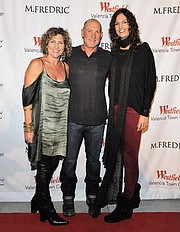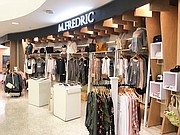The M.Fredric location in West Los Angeles in the mid-1980s. At left, a hirsute Fred Levine holds future rock star Adam Levine.
M.FREDRIC AT 40
M.Fredric at 40: Looking for New Vistas in Bricks and Mortar
Bricks-and-mortar retail has taken a lot of hits in the past decade.
Struggling against changing consumer habits and ways of doing business, many shops have closed. But a handful of high-end Los Angeles retailers stayed in the game and dominated the Los Angeles boutique scene in the late 1970s and early 1980s. Some of these shops, such as Ron Robinson and Ron Herman, pioneered retail on some of Los Angeles’ established retail streets.
Another Los Angeles–area retailer, M.Fredric, made its mark in a different venue—the established retail areas and shopping malls around new and growing big-city neighborhoods. To celebrate its 40th anniversary, M. Fredric will hold a private party on May 4 at The Village at Topanga retail center.
Siblings Fred Levine and Mardi Fox founded the contemporary shop in 1979. In the early 1980s, Fred’s wife, Lisa Levine, joined the company as a co-owner. In the 1990s, M.Fredric focused on opening stores for the growing suburban communities of Westlake Village, North Ranch, Ventura and Thousand Oaks, which straddle the Los Angeles County/Ventura County line.
More recently, M.Fredric has been focusing on opening locations in another growing field: airport retail. There are now six M.Fredric locations in airports including Los Angeles International Airport and San Francisco International Airport.
Like other businesses, M.Fredric has thrived during business booms and managed to survive during recessions. But Fred Levine said that the current era is one of the more challenging times in his business, which started before social media, the Internet and e-commerce invaded the retail scenario.
“You almost have to perform magic to be a successful bricks-and-mortar retailer,” Levine said. “We are competing with an online giant. It’s a tough competitor. We have to make the experience in-store so inviting, so fun and different from what you can find electronically.”
It’s a much different business climate than 40 years ago when Levine, who then worked as a litigator, decided to change careers. He didn’t like the adversarial style of the legal profession but thought he would enjoy being an entrepreneur.
He took a crash course in retail by working for six months for his father, Jack Levine, who ran a Los Angeles factory called JPJ California, which had outlet stores that Fred managed.
With a $30,000 loan, Fred Levine, Fox and their mother, Phyllis Levine, who passed away in 2015, opened the first M.Fredric shop on April 3, 1980, in the upscale Brentwood neighborhood of Los Angeles.
Jack Levine’s garmento friends helped stock the new shop with name brands such as Sassoon and Jordache, which sold at discounted prices. It was successful enough that the Levines felt confident to open more locations. In June, M.Fredric opened a store in Marina Del Rey. A few months later, it opened another store on Beverly Hill’s South Beverly Drive.
The stores were a true family affair. With no staff, the Levine family worked in all of the store operations. Fred transported store merchandise from downtown Los Angeles to the Westside stores in a Volkswagen van. The operation’s invoices were stored in Fred’s briefcase. By the mid-1980s, the Levines wanted to add more brand-name lines to the retail chain’s merchandise mix. But the brands’ sales chiefs put up a restriction, saying they would only work with M.Fredric if the shop sold their brands at full price.
At this time, regional malls were becoming more important, which the Levines saw as a growth opportunity. However, mall managers would only lease to merchants selling full-price clothes. The Levines complied, and the first M.Fredric full-price stores were opened in Los Angeles at the former Westside Pavilion and the Beverly Center in the mid-1980s.
At its largest, M.Fredric had around 20 locations, which included separate stores for men and kids, located from Los Angeles County’s South Bay to Ventura, Calif.
Currently, the chain operates eight stores in locations ranging from the San Fernando Valley to Ventura. Most shops include areas for kids, men and gifts.
The Great Recession took a big bite out of the M.Frederic chain. Survival for M.Fredric meant scaling back stores and cutting working hours. But they didn’t cut loyal staff.
“Everyone took a cut in salary. We made costs go down. We eliminated some overhead. Landlords gave relief when we needed to close stores and take down rent. Vendors all helped. They went 90 to 120 days, some even six months, before they got paid,” Levine said.
The warehouse in Agoura Hills, Calif., was closed Thursdays and Fridays, spurring the staff to become more efficient.
M. Fredric was able to count on forgiveness from vendors and business partners because the store’s business style is collegial, Levine said. His family worked to ensure that everyone was happy with negotiations. “My philosophy is about relationships. It’s about trust, friendship and making sure that everyone walks away from a negotiation in good shape,” he said.
Levine forecasts that the retail chain’s next growth spurt will be in airport stores. M.Fredric licensed its name to The Hudson Group to produce six stores in airports including LAX, the George Bush Intercontinental Airport in Houston, as well as the McCarran International Airport in Las Vegas. The airport stores typically range from 300 to 1,000 square feet, but they do as much volume as a 2,000-square-foot store, Levine said.
“Every airport seems to be expanding the shopping presence. They are becoming shopping malls.” The reason why they are so successful is that you have a captive customer, he said. “Bricks-and-mortar is as difficult as it gets now. One bright light is that airports are developing into shopping centers.”
























